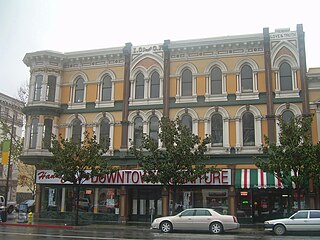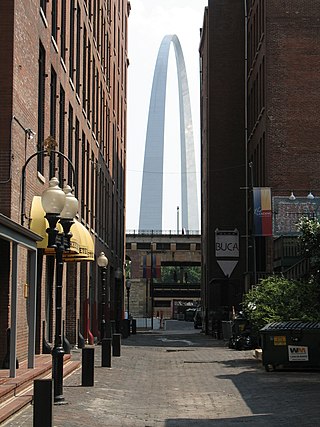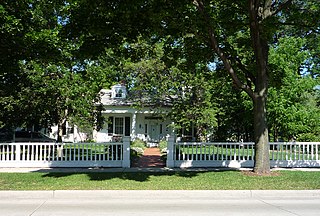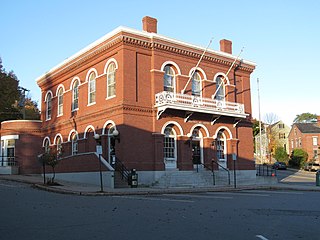
The Downtown Historic District of San Jose, California is a designated U.S. Historic District area of the city roughly the size of one square block. It is bounded by S. First Street to the west, E. San Fernando Street to the south, S. Third Street to the east, and E. Santa Clara Street to the north, but also includes the south side of E. Santa Clara Street between Third and Fourth Streets.

The Galena Historic District is a historic district located in the city of Galena, Illinois, United States. The historic district encompasses 85 percent of the city of Galena and includes more than 800 properties. The downtown area consists of three successive tiers made up of Main, Bench and Prospect Streets. Within the boundaries of the district are such notable homes as the Ulysses S. Grant Home and the Elihu B. Washburne House. The Galena Historic District was added to the U.S. National Register of Historic Places in 1969.

The architecture of St. Louis exhibits a variety of commercial, residential, and monumental architecture. St. Louis, Missouri is known for the Gateway Arch, the tallest monument constructed in the United States. Architectural influences reflected in the area include French Colonial, German, early American, European influenced, French Second Empire, Victorian, and modern architectural styles.

The Jacksonville Historic District encompasses the historic core of the 19th-century mining town of Jacksonville, Oregon. The city was a major mining, civic, and commercial center from 1852 to 1884, and declined thereafter, leaving a little-altered assemblage of architecture from that period that is unparalleled in the Pacific Northwest. The district was designated a U.S. National Historic Landmark in 1966.

There are nine historic districts in Meridian, Mississippi. Each of these districts is listed on the National Register of Historic Places. One district, Meridian Downtown Historic District, is a combination of two older districts, Meridian Urban Center Historic District and Union Station Historic District. Many architectural styles are present in the districts, most from the late 19th century and early 20th century, including Queen Anne, Colonial Revival, Italianate, Art Deco, Late Victorian, and Bungalow.

The Greenwich Avenue Historic District is a historic district representing the commercial and civic historical development of the downtown area of the town of Greenwich, Connecticut. The district was listed on the National Register of Historic Places on August 31, 1989. Included in the district is the Greenwich Municipal Center Historic District, which was listed on the National Register the year before for the classical revival style municipal buildings in the core of Downtown. Most of the commercial buildings in the district fall into three broad styles, reflecting the period in which they were built: Italianate, Georgian Revival, and Commercial style. The district is linear and runs north–south along the entire length of Greenwich Avenue, the main thoroughfare of Downtown Greenwich, between U.S. Route 1 and the New Haven Line railroad tracks.

The Haviland and Elizabeth Streets–Hanford Place Historic District is an irregularly shaped 4.3-acre (1.7 ha) historic district in Norwalk, Connecticut that was listed on the National Register of Historic Places in 1988. It encompasses a neighborhood that developed in the late 19th century following the introduction of railroad service to South Norwalk.

The Astor Historic District is a residential neighborhood located in Green Bay, Wisconsin. It was added to the Wisconsin State Register of Historic Places in 1975, and the National Register of Historic Places in 1980. The Astor Historic District is significant as the highest concentration of residences of the economic and civic leaders of Green Bay from its period of settlement well into the twentieth century. The neighborhoods's history, spanning nearly a century and a half, is reflected in the buildings and architectural styles of the district. The prosperity and influence of Astor is reflected in the scale and stylishness of its homes, particularly those from its period of greatest prosperity, 1895-1929.

The Washington Street Historic District is north of Valparaiso's downtown. The neighborhood has tree-lined streets with many examples of late nineteenth- and early twentieth-century houses and public buildings. Valparaiso began to expand after the railroads came through the township in the 1860s; Pittsburgh, Fort Wayne and Chicago Railroad, the New York, Chicago and St. Louis Railroad and the Grand Trunk Railroad. Residential neighborhoods grew up between the business district and the railroads. On Valparaiso's south side industrial and transportation area expanded, thus residential development was north of downtown.

The Belfast Historic District encompasses a large portion of the city center of Belfast, Maine, representing one of Maine's largest concentrations of pre-Civil War architecture, as well as a rich collection of commercial architecture of the late 19th and early 20th centuries. The district was listed on the National Register of Historic Places in 1986, with minor enlargements in 1993 and 1995.

The Poultney Main Street Historic District encompasses the commercial and residential historic core of the village of Poultney, Vermont. Centered on Main Street and East Main Street, between College Avenue and St. Raphael's Catholic Church, the district includes a diversity of architectural styles, as well as civic, religious, and commercial functions spanning a period of more than 100 years. The district was listed on the National Register of Historic Places in 1988.

The Wallingford Main Street Historic District encompasses the historic portions of the village of Wallingford, Vermont. An essentially linear district extending along Main Street on either side of School Street, it has a well-preserved array of 19th and early-20th century residential, commercial, and civic buildings. It was listed on the National Register of Historic Places in 1984.

Plymouth Downtown Historic District is a national historic district located in Plymouth, Marshall County, Indiana, United States. The district encompasses 47 contributing buildings and one contributing structure in the central business district of Plymouth. It developed between about 1870 and 1940, and includes examples of Italianate, Romanesque Revival, and Colonial Revival style architecture. Located in the district is the separately listed Plymouth Fire Station. Other notable buildings include the Montgomery Ward Building (1929), Metsker Block, Rentschler Building (1910), Early Plymouth Post Office (1884), First National Bank-Plymouth City Hall, Packard Bank Block (1879), Simons Building (1895), Wheeler Block, Bank Block, Bank Block-Masonic Temple (1901), Plymouth Post Office (1935), and Plymouth Motor Sales (1929).

The Rockland Residential Historic District encompasses a predominantly residential area west of the downtown of Rockland, Maine. With a history dating to the early 18th century, this area includes high quality examples of residential architecture, most dating to the period 1870-1920, and including several fine examples of municipal architecture. It was listed on the National Register of Historic Places in 1987.

The St. Johnsbury Historic District encompasses much of the historic civic and commercial center of St. Johnsbury, Vermont. Representing a significant expansion of the Railroad Street Historic District and the St. Johnsbury Main Street Historic District, it captures the historical tension and competition between Main Street and Railroad Street for primacy as the town's most important civic and commercial areas. The district was listed on the National Register of Historic Places in 1980.

The Petoskey Downtown Historic District is a commercial historic district, roughly bounded by Rose, Division, Michigan, and Petoskey streets in Petoskey, Michigan. It was listed on the National Register of Historic Places in 1986.
The Marshall Street Historic District is a primarily residential historic district, roughly bounded by Taylor, Hull, North Hudson, Montgomery and Clay Streets, in Coldwater, Michigan. It was listed on the National Register of Historic Places in 1990.

The River Ledge Historic District is a primarily residential historic district located along Jefferson, Scott, and Lincoln Streets between Franklin and Maple Streets in Grand Ledge, Michigan. It was listed on the National Register of Historic Places in 1987.

The Courthouse Square Historic District is a commercial and residential historic district, roughly bounded by Park, East Columbia, Rodgers and South Streets, in Mason, Michigan. It was listed on the National Register of Historic Places in 1985.

The Charlotte Central Historic District is a mixed commercial, residential, and historic district located in the downtown section of Charlotte, Michigan. The district stretches along Cochran Avenue from West McClure Street to south of Henry Street, containing portions of the streets adjacent to Cochran. It was listed on the National Register of Historic Places in 2020.





















